PMP® Certification Training
- 77k Enrolled Learners
- Weekend/Weekday
- Live Class
Project Management is the discipline that helps in organizing and managing the objectives of a project in a controlled manner to produce unique outcomes. The profession of the Project Manager traces back to the early 19th Century but was not recognized as a distinct profession until the late 20th century. But in today’s market, it is recognized as one of the most reputed professions offering a lucrative salary. But grasping it is definitely not a piece of cake, where you will have to compete with others across the globe. This blog is going to help you crack all your PMP Interview Questions.
You can also, check out our PMP Certification Training if you want to ensure your job as a project manager because certifications like PMP, Prince2, etc. help in beefing up your resume and are preferred by employers globally.
| Course Name | Upcoming Batches | Fees |
| PMP certification training | 27th Jul 2024 (Weekend Batch) | ₹13,999 |
| PMP certification training | 10th Aug 2024 (Weekend Batch) | ₹13,999 |
| PMP certification training | 12th Aug 2024 (Weekday Batch) | ₹13,999 |
Apart from this blog, you can also check out our video on PMP Certification Full Course.
So, let’s get started with our PMP Interview Questions.
Explain what you know about the principle of “Six Thinking Hats” in PMP
Elaborate on the Project Management Life Cycle process?
What is your leadership style?
What are the processes and process groups in the project management framework?
Explain Ishikawa/ Fishbone diagrams.
So let’s get started with Beginner Project Manager Interview Questions.
| Project | Program | Portfolio |
| An endeavor undertaken to produce a unique product or solution | A group of interrelated projects that are managed together | A collection of projects and operations managed under one group to achieve a strategic goal |
| Temporary in nature with defined start and end point | Temporary in nature but lasts longer than project | Permanent in nature that keeps on changing and is aligned with the strategic planning |
| Follows the project-level plans with the main focus on detailed delivery | Follows the high-level plans that are backed up by detailed plans | Follows the ongoing processes that prioritize and align the portfolio to achieve strategic objectives |
| Has a narrow and defined scope with no changes | Has a wide scope can change with time-based on client requirements | Has the widest scope with the strategic perspective of the whole organization |
“Six Thinking Hats” is an interesting way of understanding an issue from a variety of perspectives. You can think from 6 different perspectives or you and your team members could do this. Now, each of the 6 hats represents a different point of view.
Let us talk about it one by one:
The White Hat: A person who has the white hat will talk only about the Information, you have to consider it from both within and outside the scope of the discussion.
The Yellow Hat: The yellow hat symbolizes brightness and optimism. The wearer of this hat should bring or think of positive aspects related to the subject as much as possible. They should encourage the team members.
The Black Hat: A person who has the black hat is responsible for identifying any mistakes or roadblocks. They should be judgmental. Think about everything that could go wrong. Think about worst case scenarios, so that others can find a solution for it.
The Red Hat: A person with the red hat should express his feelings. The red hat signifies emotions. You can express emotions and feelings and share likes, dislikes, loves & hate. The objective here is to address the credibility of the emotions that are part of a certain discussion.
The Green Hat: A person wearing the green hat should come up with new innovative ideas. They should be creative. They should know all the information, problems and come up with new ideas that solve the problems and help in better productivity. The main purpose of earring this hat is to generate as many new ideas as possible.
The Blue Hat: The blue hat is the thinking hat(cap). It is all about thinking. It is the hat which ensures the six thinking hat guidelines are observed.
They decided the agenda and timeline, how long do the sessions take? When do you need to wear a particular hat, and for how long? So the group’s controller should wear the blue hat for the session.
Learn more about ITIL and its framework from the ITIL Foundation Certification.
As per Project Management institute, a project is a ‘temporary endeavor with a definite beginning and end’ . To explain this in simple terms, A project can be defined as a sequence or series of tasks that should be completed to obtain the end result. A project could range from simple to complex, it could be handled by one team or by many teams. Now, every project will have these listed characteristics:

Project Management is the discipline that helps in implementing various processes, methods, knowledge, skills, and experience for achieving the objectives of a unique project. Project Management is nothing like the usual management. One key factor which differentiates these two is that project management has a final deliverable and a definite timeline whereas management is an ongoing process. A project manager must always follow the 6P rule of project management which is Proper Planning Prevents Poor Project Performance.
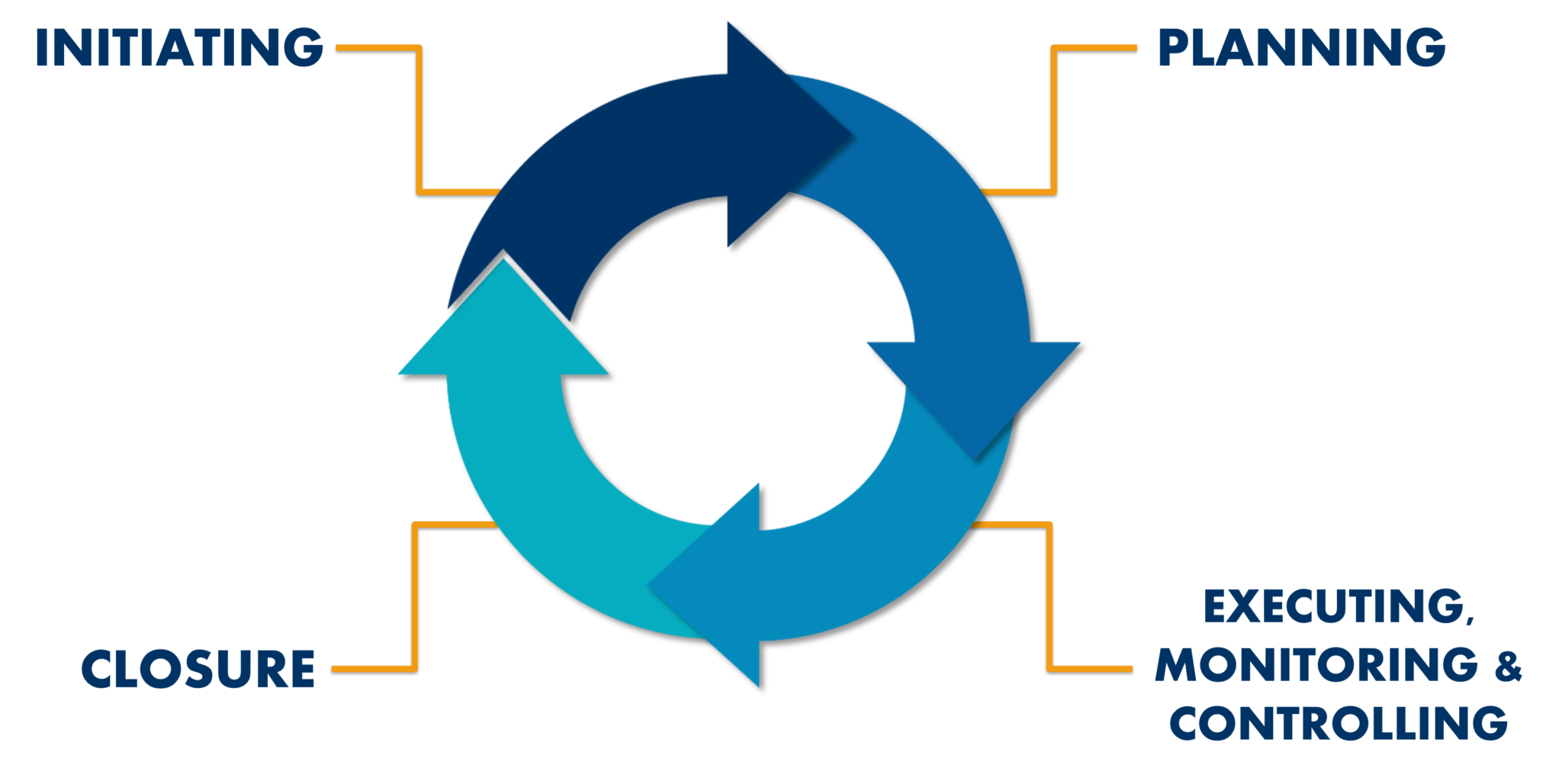
The Project Management Life Cycle is a series of various activities/tasks that are crucial for accomplishing project objectives or targets. This helps in structuring the efforts and simplifying them into a series of logical and manageable steps. The Project Management Life Cycle consists of four simple phases which are listed below:
Next, let’s look at the techniques that you can use to collect project requirements.
Before, we talk about the techniques used to collect project requirements, let us first understand what is project requirements. Project requirements can be defined as “what stakeholders expect from a project, or from the product of the project”. So, all these requirements should be collected in the project and also managed properly. Now, some of the important techniques that you can use to collect project requirements are:
Requirements Traceability Matrix or RTM is a document which ensures that all the requirements that are defined for a particular system are linked at each and every point during the verification process. RTM also assures that they are tested with respect to various test parameters and protocols. The importance of maintaining requirement traceability matrix is that:
RTM can be defined as a powerful planning tool which helps in determining various factors like, the required numbers of tests, what are the types of test required or whether these tests can be automated, done manually, or whether any existing tests can be reused.
Also, using the RTM you get results in the most effective test execution which provides reports of the overall defect status, focusing majorly on business requirements.
Related Learning: PMP Exam Interview Questions
Project charter is a document which includes all the details of the project. It mainly includes information about the scope, objectives and the individuals who are involved in the project( It also includes roles and responsibilities of each project member). This project charter acts as a contract between the sponsors, key stakeholders and the project team.
Most important skills that a Project manager must possess are:
When you start your job a project manager first few things that you need to take care of are:
Note: The above questions are frequently asked Project Manager Interview Questions. With that, let’s move ahead.
Prioritizing tasks in a project is very important and especially if it is an extensive one. It helps in ensuring successful and timely completion of your project. In order to prioritize the tasks you should follow the below pointers:
Leadership is a quality that every project manager must possess. Every leader has his own leadership style to guide his team. The leadership style refers to a leader’s characteristic behavior while directing, motivating, guiding, and managing his team to bring the best out of them. In a project, they hold the responsibility to motivate others for better performance, creation, and innovation.
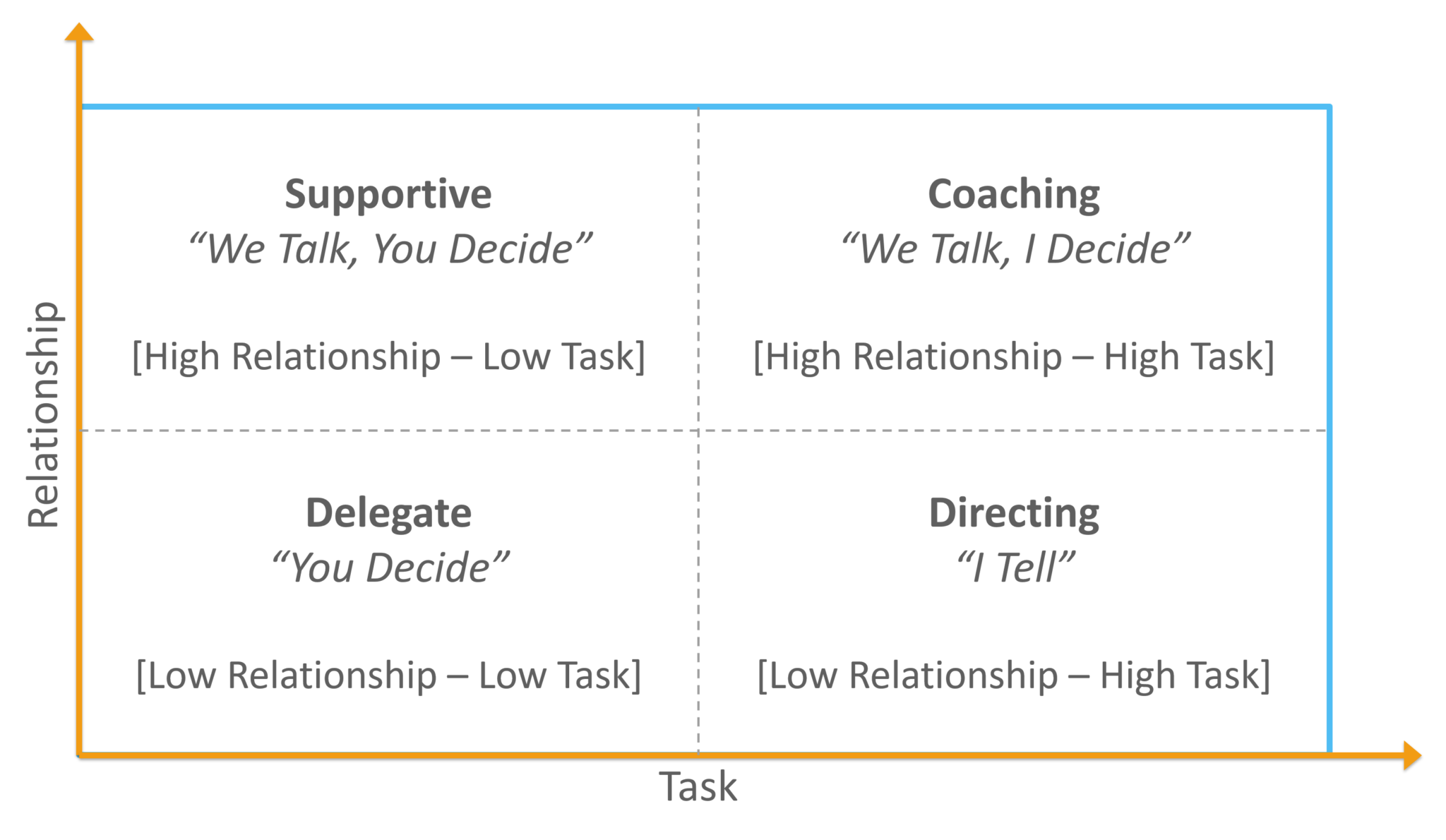
There are basically four types of leadership styles and your leadership style should be situational, depending on the type of team you are working with and the importance of the tasks involved in the project. Below are the four leadership styles:
Before you decide on your ideal project, you must consider the following questions. These questions will help you in narrowing down your choices while making sure that your productivity maximizes.
An organizational structure determines a lot of factors that influence resource acquisition such as the level of project management, organization’s environment, the communication between the team members, how the project manager works with the team and many more.
Now, talking about a few points how organizational structure influence resource acquisition:
1). Project management: During the process of your project management, your organization structure can either be a tight structure where all the steps that you take are managed very closely or a loose structure where there are not many rules and a little liberty in performing the tasks.
2). Communication: The communication between the team members to complete a project is greatly impacted by the organizational structure. There should be good communication between the team members and also inter departmental communication in an organization. It will create a friendly environment where people can share their ideas and suggestions, which in turn help in the project to thrive.
3). Chain of Command Impact: This means the hierarchy of the organization. The organization structure should be in such a way that when higher authorities communicate their requirements, it should be well understood and followed by the project manager and the subordinates correctly. Also, The project manager should know his subordinates, so that he can pick the right people for a particular task. They should be authoritative as well as friendly, they should communicate and express their thoughts clearly. All the tasks given by the management should be communicated properly to the subordinates and the management should allow the project manager to perform their own way of getting the work done.
Find out our PMP Training in Top Cities/Countries
| India | Other Cities/Countries |
| Bangalore | UK |
| Hyderabad | US |
| Pune | Canada |
| Chennai | Australia |
| Mumbai | Singapore |
| Kolkata | Saudi Arabia |
So, let’s get started with intermediate Project Manager Interview Questions.
Both are equally important as both are customer-oriented. The development team develops products for customers, while the customer team helps customers with the products. A project manager should invest equal time with both teams, understanding their requirements and solving their problems to increase their productivity.
A process in the project management framework is a defined way of doing tasks that are involved in the successful completion of a project. These processes define the actions to be taken along with their sequence. There are around 49 processes in the project management framework embedded in various process groups. Process groups are a collection of processes that are applicable through various stages of a project.
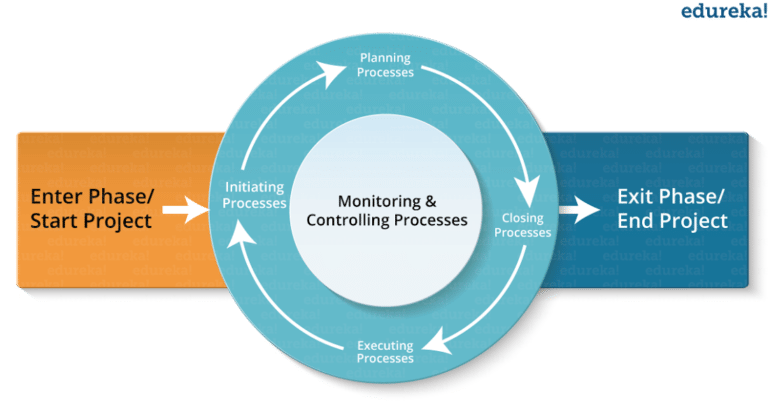
There are 5 process groups in which 10 knowledge areas and 49 processes are mapped into. The five process groups are:
Note: Project Management Framework is one of the most asked and demanded Project Manager Interview Questions.
Knowledge Areas are the core technical subject matter that are vital for effective project management. All the 49 processes are primarily part of these knowledge areas where they are grouped based on their commonalities. Below I have listed down the 10 knowledge areas of project management framework:
Since stakeholders hold a high authority and are an integral part of a project having their consent is very important. But sometimes they can be little difficult to handle, in such cases should:
RAID in project management stands for Risk, Assumptions, Issue, and Dependencies. These are very important items that a project manager must have knowledge about.
Every individual in a project should understand his/ her roles and responsibilities. Each team member’s role can be defined using a RACI matrix.
RACI stands for the 4 roles which stakeholders may portray in any project. It maps out to is Responsible, is Accountable, who must be Consulted with, and who shall stay Informed. Just to explain this better, a project delegation looks like with RACI.
Responsible – Defines who is completing the task.
Accountable – Defines who is making decisions and taking actions on the tasks.
Consulted – Define who will be communicated with regard to decisions and tasks.
Informed – Defines who will be updated on decisions and actions taken during the project.
With the RACI matrix there will be no role or task-related ambiguity among the team members. It defines details like what level of responsibilities each person has, who to report to , and also when to ask guidance from project manager and when to take their opinion.
Critical path method or CPM is a resource utilization algorithm which is used for scheduling project activities. So this algorithm is used to create a structure in which the tasks are executed. So to construct a CPM, you should includes the following things:
Based on these criteria, you can prioritize the tasks which have to be performed on priority.
To detect whether your project is on track or falling behind the agreed timeline, you must check the below pointers:
If the answers to these pointers are true then, your project is definitely off the track and you must take immediate action to bring it back on track. Few steps that you might take are:
Effort variance in simple terms can be defined as the difference between the planned effort and the actual effort required to undertake the task.:
Now, to calculate the effort variance, here is the formula
Effort variance = (Actual Effort – Planned Effort)/ Planned Effort x 100.
Not a single methodology can be applied to all types of projects. The selection of project management methodology must be based on the following criteria:
A bid document is a document that comprises a proposal, which is often made through a bidding process, by a person or company and will include certain important factors like delivery schedule , the availability of the product, pricing and so on.
The different kind of bid documents can be used for procurement management are:
Majorly used tools in the industry:
So, let’s get started with Advanced Project Manager Interview Questions.
Stakeholder Analysis is the technique used for identifying, analyzing and prioritizing potential stakeholders who might be associated with the project in some way or another. It can also be defined as a process which should take place before the project begins, where you identify or analyze the stakeholders and group them according to various factors like their interest in the project, their contribution to the project and their influence to the project. This helps in determining how to prioritize and communicate with different stakeholders. Now, analyzing stakeholders will give you all the necessary information about who they are, what their needs or expectations may be, what issues matter to them and many more. All of this information can be very helpful in making your projects successful.
A power-interest grid is used for classifying the stakeholders according to their power over the project and their interest on its results; based on these two criteria’s you can allocate a position for each one on the power- interest grid.

To bring the best out of your team members, you must:
Trust and agreement is a key factor that facilitates proper communication and coordination in a team. that brings ou the best outcome. To gain agreement from your team members you must:
A fishbone diagram is also known as a cause and effect diagram or Ishikawa diagram. It is a visualization tool that is used for categorizing the potential causes of a problem in order to identify its root causes. A Japanese quality control expert named Dr. Kaoru Ishikawa invented this fishbone diagram in order to help employees to avoid solutions that will merely address the symptoms of a much larger problem.

Firstly, DMAIC and DMADV are methodologies which are designed so that a business process will be more effective and efficient.
| DMAIC | DMADV |
| 1). DMAIC stands for Define—Measure—Analyze—Improve—Control | 1). DMADV stands for Define—Measure—Analyze—Design—Verify |
| 2). DMAIC is limited to improving existing processes, it does not address anything regrading the design of new products, services, or processes. | 2). DMADV is majorly focused on the process of designing new products, services or processes. |
| 3). D stands for defining the problems, which all output has to be improved, customers, and the process associated with the problem | 3). D stands for Define design goals |
| 4). M stands for measuring the data to make a baseline for improvements. | 4). M stands for measure and identify characteristics that are critical to quality |
| 5). A stands for analyzing the data to find the main cause for the defect | 5). A stands for analyzing the data to find the best design |
| 6). I stands for improving the process by trying out different ideas and solutions. | 6) Stands for planning and designing the product, service or process. |
| 7). C stands for controlling process implementation to sustain the improvements. | 7). V stands for verifying if the designed product works well as planned under real time and simulated conditions. |
Developmental stages of the team generally consist of:
There are two ways in which you can calculate the three-point estimation:
where P = pessimist, O = Optimist, M = most likely.
35. Explain the Work Breakdown Structure (WBD) and its effect on the work estimates of tasks/activities?
Work breakdown structure defines the work activities that are required for the project completion and the sub-activities of each of those work requirement. It has a hierarchical structure in which concrete/ main activities are segregated into logical sub-activities. There are two approaches:
WBS stands for Work breakdown structure which is a very important step in preparing a good plan . As the name suggests, WBS is breaking up the project work into smaller and manageable parts which are known as work packages. WBS helps in preparing a good plan as it is integrated with cost, scope and schedule baselines which ensures that the project plans are going as planned.
So instead of planning for the entire project, it would be easier and more efficient to break the project into parts and then plan for those individual parts. So it will be easier to plan and even when there is a problem, it is easier to identify and solve the problem. A good WBS helps to achieve optimal results and leads to development of an robust and accurate plan.
Planned Value: Planned value is the budget which is authorized to an activity or work breakdown structure (WBS). This planned value can be allocated in various phases over the lifetime of the project.
To calculate Planned Value (PV) use the relation:
PV= BAC x Planned % of complete.
Earned Value: EV is a measure of work performed/ budget authorized for that work. In simple words, it’s the budget authorized for completed work.
To calculate EV, you’d use the relation:
EV = Total percentage of work completed x BAC
Actual Cost: It is the cost which is incurred for the completed work on a task during a specific time period. In simple words, the cost you incur while you’re completing the work for which EV is measured.
AC can be measured as it relates to PV (which is budgeted) and EV (which is measured).
Related Learning: What is Earned Value Analysis?
| Issues | Risks |
| Issues are more of present focused | Risks are more of future focused |
| These always tend to be negative in nature | They can be either, positive or negative |
| Issues are generally documented in “Issue Register” | Risks are generally documented in “Risk Register” |
| The response to an issue will be “Issue workaround” | The response to risk is based on “risk response planning” |
Proactive Managers have higher chances of finding out the risks and implementing solutions in order to minimize them. Being proactive, lets them have more control over their project tasks and resources. They can keep a better track of all tasks and issues to work towards implementing small changes and improvements for higher productivity and efficiency. Organizes frequent meetings for developers to talk about their problems, brainstorm solutions, share best practices etc. Compares the actual costs and time spent on tasks on a weekly basis with the planned numbers.
Risk Probability is the chance that a risk will occur whereas Risk Impact is the cost when a risk does occur.
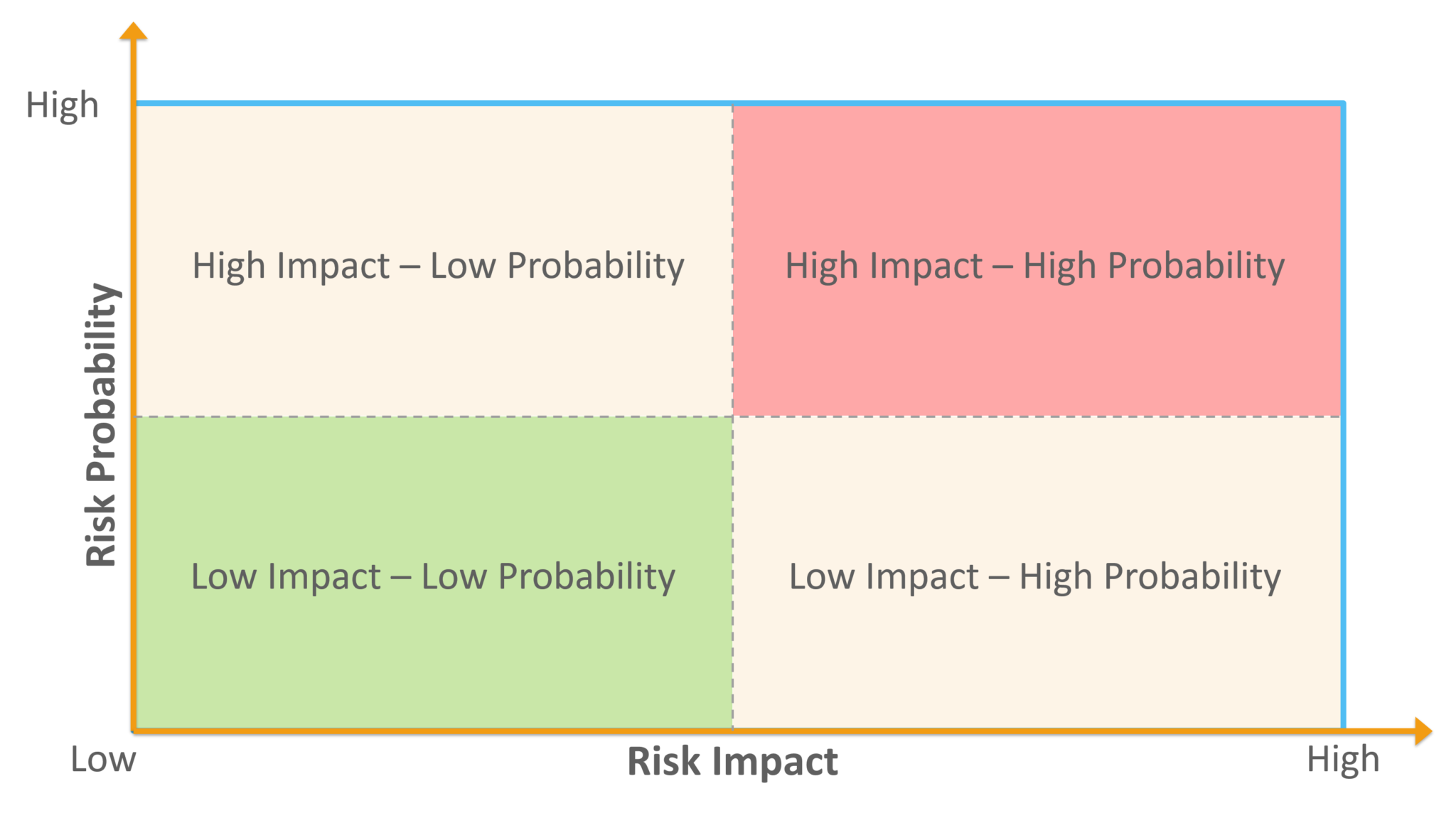
There are 5 important steps in risk planning:
Step 1: Identify the Risk. This step includes identifying and describing all the possible risks that might affect your project or its results, so to avoid this make a note of all the possible risks. During this step, you start to prepare a Project Risk register which is a register the keep the details of all the possible risks
Step 2: Analyze the risk. Once risks are identified, the next step you should take is to analyze the likelihood and consequence of each risk. This is a very important step because you will understand the nature of the risk and its effect on project goals and objectives. You should also input this information to your Project Risk Register.
Step 3: Prioritize the Risk: After analyzing all the possible risk, it is time for you to evaluate and prioritize the risk by determining the risk magnitude, now the risk magnitude can be calculated as the combination of likelihood and consequence. So on top will be the risks, which have the most chances of occurring and whose consequences are bad for the project and vice versa . You should add all these risk rankings to your Project Risk Register.
Step 4: Treat the Risk. During this step you analyze the highest ranked risks and plan strategies to treat or avoid these. You create risk prevention & reduction strategies and also any plans for emergency in this step. Then you add the risk treatment measures as the highest ranking risks on your Project Risk Register. This is also called Risk Response Planning.
Step 5: Monitor and Review the risk: This is the step where you review your Project Risk Register and with the help of it track, Review and monitor risks.
PDCA cycle stands for Plan-Do-Check-Act (PDCA) Cycle. It is a 4 step problem solving technique which is used to improve business processes. It was originally developed by an American physicist named Walter A. Shewhart. It is a cycle, which means it keep iterating or repeating these 4 steps.
The first step is Plan: This step includes planning a project in such a way, that it defines clearly what is the project’s goal and what are the best ways to work towards the goal. It is basically, setting up a framework for all the operations that should be done.
The second step is do: This step includes executing the actions which were planned. This do stage can be broken down into parts, the first part includes assigning tasks to individuals and training them, the second part includes the actual process of doing the work and the third part is noting down the progress and insights for future evaluation.
The third step is check: This step is used to check if the project’s objectives are met. It also includes checking if the completed project addresses both the successes and failures, so that any further changes have to be made.
The fourth step is act: This step includes performing any corrective actions that were needed after the evaluation in the previous step. This cycle can be repeated until you get the optimal results.
Type of communication you use in your project will completely depend on the type of project you are working on and the type of team you have. Types of communication styles that a project manager uses:
It is a type of contract that is a hybrid contractual arrangement containing aspects of both cost-reimbursable and fixed-price contracts. Time and material contracts resemble the cost-reimbursable type arrangements where they have no definitive end. This contract is generally used in projects whose accurate project size can’t be estimated or when it is expected that the project requirements would most likely change.
To handle an unhappy customer, you must:
Pareto Analysis is a statistical technique in decision-making. It is basically used for the selection of a limited number of tasks which can bring a significant overall effect. This principle follows the Pareto Principle (also known as the 80/20 rule) and states that 80% of the results come from 20% of the actions. It helps in prioritizing the work especially in large projects with a number of small tasks.
DSS or a decision support system is an informational application which basically provides the users, relevant information which it has collected from a variety of data sources. This DSS can help by providing information which leads to better decision-making.
A Decision Support System is made up of three different parts:
Knowledge base. It is a part of a database of the decision support system, it contains all the information which are basically collected from both internal and external sources.
Software system: This is composed of model management systems. Now, a model is basically a simulation of a real-world system with the goal of understanding how the system works and how it can be improved.
User interface: The primary goal of the decision support system’s user interface is to make it easy for the user to change the data that is stored on it.
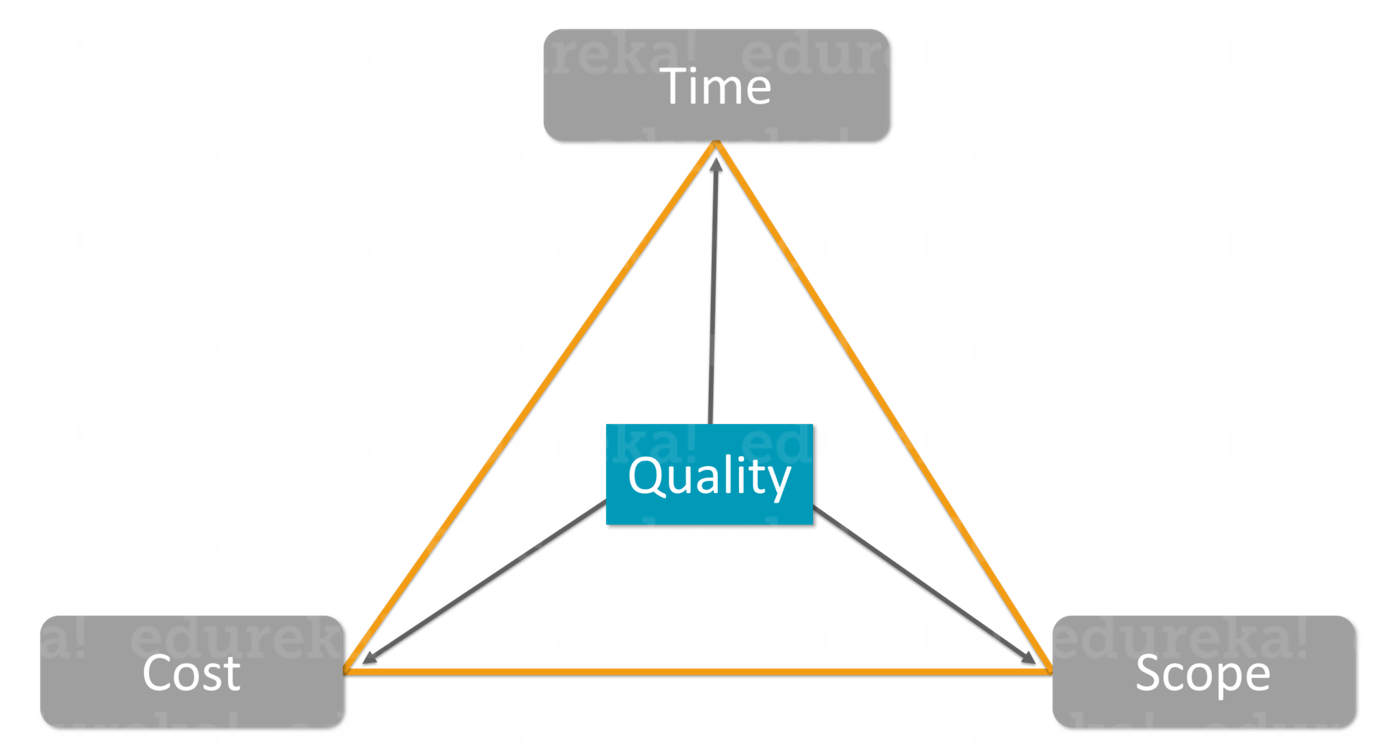
Triple Constraint Triangle is a combination of three key components which acts as the most significant restrictions on any project. Following are the three constraints in this model:
Each of the constraints forms the vertices of the triangle with quality as the central factor.
Majorly encountered risks in a project are:
Now, you can answer this question by saying that you are very well prepared to manage a remote team. Then, you can talk about a few points on how you will manage the remote team. Some of the pointer that will help you answer this question is:
1) Have a well organized workspace.
2) Have clear communication with team members
3) Conduct weekly meetings to discuss project updates and address any problems regarding the project.
4) Prioritize the important tasks and work on that first.
5) Use project collaboration tools to improve the productivity of the tasks and also the team.
Now, the answer for this question will change for every individual. But, before you go to the interview, learn about the company, understand how the company carries out its work. So according to the answer this question. Some of the point you can use here is,
| QC(Quality Control) | QA(Quality Assurance) |
| QC is used to verifying the quality of the output | QA is the process of managing for quality |
| QC is done in the end where they check if the end products meet the expected standards | QA is done throughout the execution and development process |
| QC is a strategy for detection | QA is a strategy for prevention |
According to PMBOK (Project Management Body of Knowledge): “an identified area of project management defined by its knowledge requirements and described in terms of its processes, practices, initial data, results, tools and techniques that compose them.” Now, all Project Management is the discipline that helps in organizing and managing the objectives of a project in a controlled manner to produce unique outcomes. processes in the PMBOK are divided into 10 areas, which are:
Now, in this question, you will have to explain your reason for choosing PMP Certification.
Here are some pointers that might help you prepare for the answer:
Your professional growth is guaranteed with PMP Training! Join our Training Course and make yourself job-ready. You can also join our PRINCE2 Certification program to boost your qualifications.
Here are the top technologies to learn in 2023
This brings us to the end of this article on the Top 50+ PMP Interview Questions. I hope it helped to expand your knowledge. If you prepare these questions, you will surely crack your PMP interview successfully. I wish you all the best for your interview. Happy learning.
If you found this article relevant, check out the Project Management Training Program by Edureka, a trusted online learning company with a network of more than 250,000 satisfied learners wordlwide.
Do you have a question for us? Please mention it in the comments section, and we will respond to you.
| Course Name | Date | Details |
|---|---|---|
| PMP® Certification Training | Class Starts on 27th July,2024 27th July SAT&SUN (Weekend Batch) | View Details |
| PMP® Certification Training | Class Starts on 10th August,2024 10th August SAT&SUN (Weekend Batch) | View Details |
| PMP® Certification Training | Class Starts on 12th August,2024 12th August MON-FRI (Weekday Batch) | View Details |
 REGISTER FOR FREE WEBINAR
REGISTER FOR FREE WEBINAR  Thank you for registering Join Edureka Meetup community for 100+ Free Webinars each month JOIN MEETUP GROUP
Thank you for registering Join Edureka Meetup community for 100+ Free Webinars each month JOIN MEETUP GROUP
edureka.co
